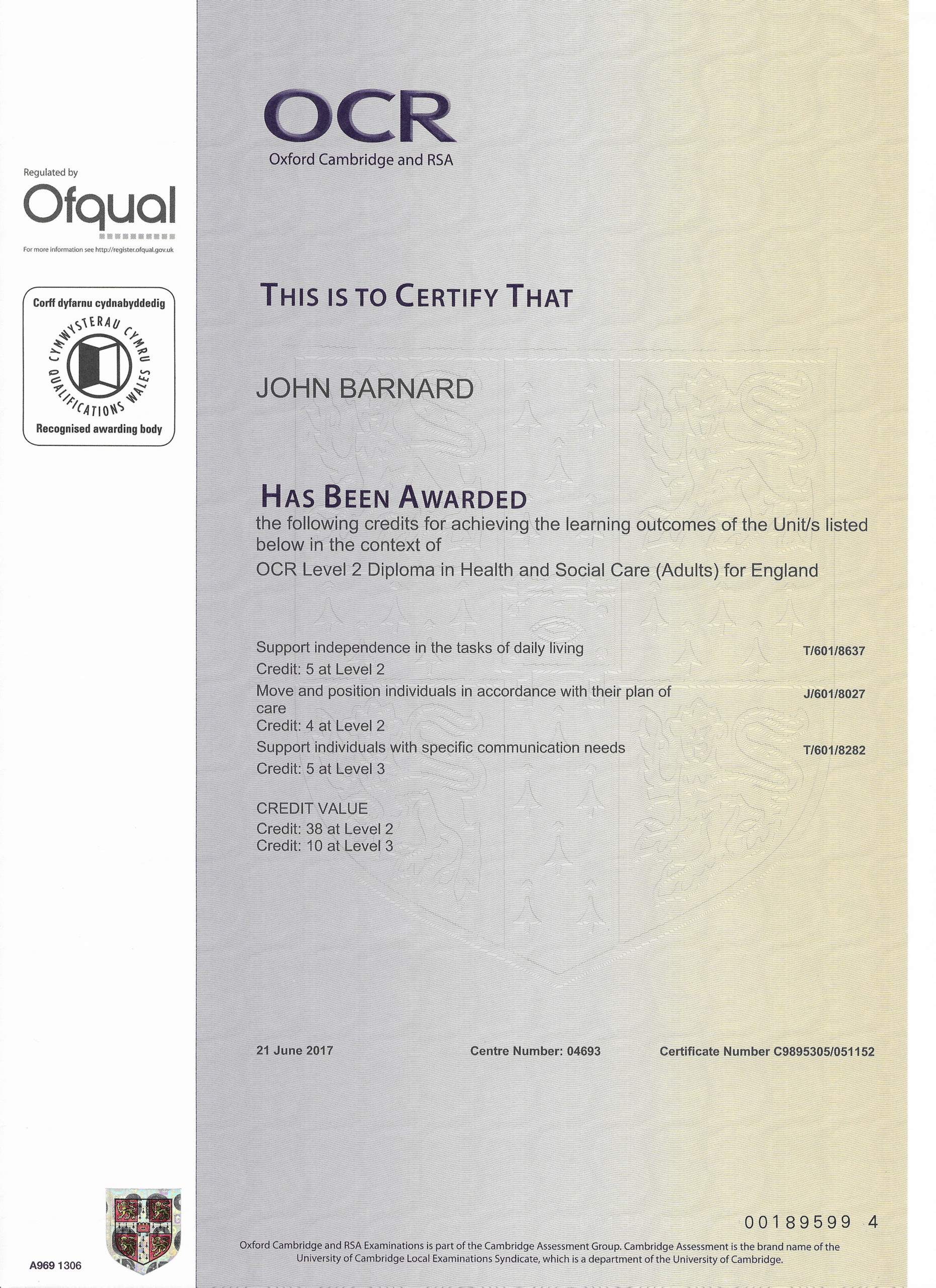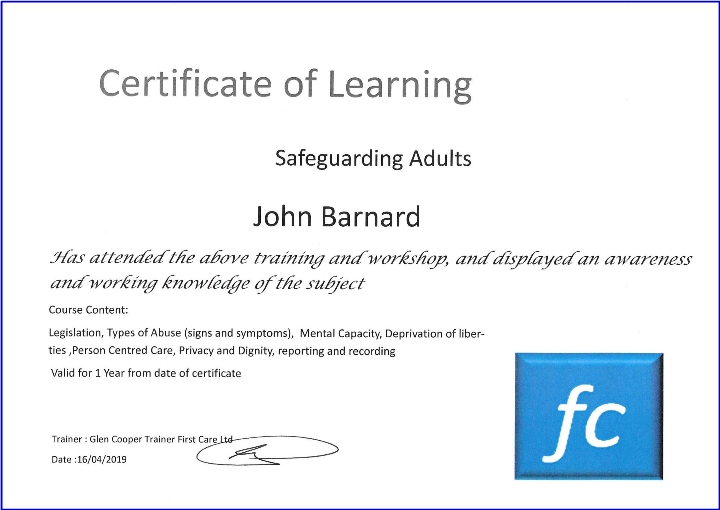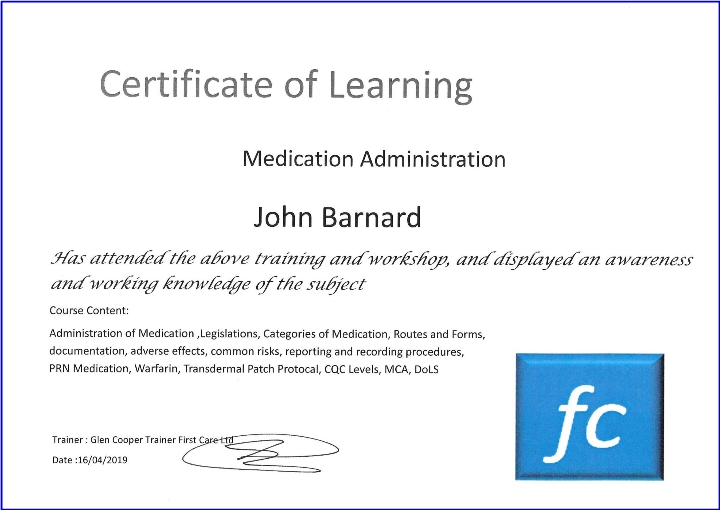Some of my Qualifications…










Everybody Needs a Carer
Some of my Qualifications…









Companion care refers to a form of non-medical assistance provided to individuals who may require support with various daily activities, emotional companionship, and social interaction. It is typically offered to older adults or individuals with disabilities who may be living alone or facing difficulties in managing their daily routines.
Companion care services are designed to enhance the overall well-being and quality of life of the individuals receiving care. They focus on addressing the non-medical needs and promoting independence, self-esteem, and social engagement. Here are some key aspects of companion care:
It’s important to note that companion care differs from medical or skilled nursing care, as it does not involve providing medical treatment or performing invasive procedures. Instead, it focuses on holistic support and enhancing the quality of life for individuals in need.
Overall, companion care plays a vital role in supporting individuals who may require assistance with daily activities, emotional well-being, and social interaction. By providing compassionate companionship and non-medical support, companion caregivers contribute to the overall health, independence, and happiness of their clients.
Domestic care, also known as home care or in-home care, refers to a range of services provided to individuals in their own homes to assist with daily activities, household tasks, and personal care. It is primarily aimed at older adults, individuals with disabilities, or those recovering from illness or surgery who require assistance but prefer to remain in the comfort and familiarity of their own homes. Here’s a thorough description of domestic care:
Domestic care is designed to promote independence, enhance the quality of life, and provide a safe and supportive environment for individuals who prefer to receive care in their own homes. It allows them to maintain their familiar routines, be surrounded by cherished possessions, and receive personalized attention from trained caregivers. By providing comprehensive assistance with daily activities, household tasks, and emotional support, domestic care enables individuals to age in place and maintain their autonomy and dignity.
Compassionate care refers to the provision of care and support with empathy, sensitivity, and a deep understanding of the physical, emotional, and psychological needs of individuals. It is a holistic approach to care-giving that focuses on addressing not only the medical or physical aspects of a person’s well-being but also their emotional, social, and spiritual needs. Compassionate care aims to enhance the quality of life, promote dignity, and provide comfort to those in need. Here’s a thorough description of compassionate care for your portfolio:
At the core of compassionate care is a genuine sense of empathy and understanding. As a caregiver, I strive to create a nurturing and supportive environment where individuals feel valued, respected, and heard. I approach each person with compassion, recognizing that their experiences, emotions, and needs are unique and deserving of attention.
In providing compassionate care, I acknowledge that individuals may be facing various challenges, whether physical, emotional, or both. I actively listen to their concerns, allowing them to express their feelings and fears without judgment. I provide a comforting presence, offering reassurance and understanding, and acknowledging the importance of their emotional well-being.
One of the key aspects of compassionate care is fostering open and honest communication. I engage in conversations with individuals and their families, encouraging them to actively participate in decision-making regarding their care. By involving them in the process, I empower individuals to have a sense of control and autonomy over their own lives.
Compassionate care extends beyond addressing immediate physical needs. It encompasses the provision of comfort and support. This may involve managing pain and discomfort through medication administration, gentle touch, or the use of relaxation techniques. I prioritize the creation of a calm and soothing environment that promotes relaxation and a sense of well-being.
Recognizing that each person has their own unique story and background, I strive to provide culturally sensitive and inclusive care. I am mindful of individual preferences, beliefs, and values, ensuring that care is delivered in a manner that aligns with their cultural, spiritual, and religious practices. This helps individuals maintain their identity and sense of self.
Compassionate care is not limited to the individual alone. I understand the importance of supporting and involving the families and loved ones of those in my care. I provide emotional support, guidance, and education to help families navigate the challenges they may face. I collaborate with them to develop care plans that are respectful of their wishes and preferences.
Additionally, I recognize that compassionate care involves a multidisciplinary approach. I collaborate with healthcare professionals, therapists, and other members of the care team to ensure a comprehensive and coordinated approach to care. This collaboration allows me to provide the best possible care, utilizing the expertise and resources available.
Compassionate care also involves advocating for the rights and well-being of individuals. I strive to ensure that their voices are heard and respected in all aspects of their care. I am attentive to their needs, preferences, and concerns, acting as their ally and supporting them in making informed decisions about their health and well-being.
In summary, compassionate care is the embodiment of empathy, understanding, and holistic support. It encompasses emotional, physical, and spiritual aspects of care, with the goal of enhancing the overall quality of life and promoting dignity for individuals. By providing compassionate care, I aim to make a positive difference in the lives of those I have the privilege to serve, offering comfort, support, and a sense of empowerment during challenging times.
Child care refers to the professional care and supervision provided to children in the absence of their parents or primary caregivers. It encompasses a range of services aimed at ensuring the safety, well-being, and development of children in a nurturing and supportive environment. Child care providers play a crucial role in the early years of a child’s life, fostering their growth, learning, and socialization. Here’s a thorough description of child care for your portfolio:
In summary, child care providers play a vital role in ensuring the well-being, development, and safety of children in their care. By creating a nurturing environment, offering age-appropriate activities, promoting socialization and learning, and collaborating with parents, they contribute to the overall growth and development of children during their early years. Child care providers make a lasting impact on children’s lives, providing them with a strong
Private Family Care, also known as private home care or personalized care, refers to care-giving services provided directly to individuals or families within the comfort of their own homes. Unlike institutional or facility-based care, private family care offers a more personalized and one-on-one approach, tailored to meet the unique needs and preferences of the individuals or families seeking assistance. Here’s a thorough description of private family care for your portfolio:
In summary, Private Family Care provides personalized and individualized care-giving services directly to individuals or families within their own homes. By offering companionship, personal care, household management, and health support, private family caregivers contribute to the well-being, independence, and quality of life
Stroke care refers to the comprehensive medical and rehabilitative services provided to individuals who have experienced a stroke. A stroke occurs when the blood supply to the brain is disrupted, leading to a lack of oxygen and nutrients reaching brain cells. This can result in the death of brain tissue and cause a range of physical, cognitive, and emotional impairments.
Stroke care is a multidisciplinary approach that involves a team of healthcare professionals working together to provide timely and appropriate interventions to minimize the long-term effects of a stroke and promote recovery. The goal of stroke care is to improve the quality of life for stroke survivors and help them regain as much independence as possible.
The components of stroke care include:
Stroke Care is a dynamic and evolving field, with ongoing research and advancements aiming to improve treatment strategies and outcomes. The integration of technology, telemedicine, and innovative rehabilitation techniques continues to enhance the delivery of stroke care and optimize patient recovery.
Respite and crisis care are two distinct types of care services provided to individuals in need of temporary assistance or facing urgent situations. Here’s a thorough description of each:
Key aspects of respite care include:
a. Temporary relief: Respite care offers temporary relief to caregivers who may be experiencing physical, emotional, or mental exhaustion due to their ongoing care-giving responsibilities. It allows them to take time off, engage in self-care, attend to personal needs, and rejuvenate, knowing that their loved ones are being well cared for.
b. Care continuity: During respite care, the temporary caregiver steps in to provide personalized care and support based on the specific needs of the individual receiving care. This may include assistance with activities of daily living (ADLs), medication management, meal preparation, companionship, and any other necessary support.
c. Flexibility: Respite care can be tailored to the unique requirements of the individual and their caregivers. It can be provided in various settings, such as the care recipient’s home, a respite care facility, or a specialized program within a healthcare or community setting. Respite care can be scheduled regularly, such as a few hours per week or a few days per month, or arranged on an as-needed basis.
d. Person-centered care: Respite care providers strive to maintain continuity and familiarity in the care recipients’ routines, preferences, and environment to ensure comfort and minimize disruption. They work closely with caregivers and families to understand the individual’s specific needs, preferences, and goals, ensuring that the care provided aligns with their overall care plan.
e. Emotional support: Respite care recognizes the emotional challenges faced by both caregivers and care recipients. Providers offer emotional support and a compassionate approach, fostering a trusting relationship with both the individual receiving care and their primary caregiver. This can help alleviate stress and enhance the overall well-being of all involved.
Key aspects of crisis care include:
a. Immediate response: Crisis care services are designed to provide an immediate response to critical situations. This may involve rapid assessment, stabilization, and necessary medical or psychological interventions to address the urgent needs of the individual. Crisis care can be provided in various settings, such as emergency departments, crisis stabilization units, or specialized crisis intervention centres.
b. Safety and risk management: Crisis care focuses on ensuring the safety of the individual in crisis. This includes addressing immediate physical health concerns, mitigating risks, and managing any life-threatening conditions. In the case of mental health crises, crisis care providers work to stabilize the individual’s condition, ensure their safety, and provide support until further treatment or care can be arranged.
c. Collaborative approach: Crisis care involves collaboration among various healthcare professionals, including doctors, nurses, mental health specialists, and social workers. These professionals work together to assess the situation, develop a crisis management plan, and provide the necessary interventions and support. Collaboration may also extend to involving family members or support networks to ensure comprehensive care.
d. Transition and follow-up: Once the immediate crisis is stabilized, crisis care providers typically work on facilitating a smooth transition to ongoing care or appropriate services. This may involve arranging follow-up appointments, referrals to specialists or community resources, or coordinating with the individual’s existing healthcare providers. They ensure that the individual receives the necessary support and care beyond the immediate crisis period.
e. Mental health crisis intervention: Crisis care often includes specialized mental health crisis intervention for individuals experiencing acute psychological distress or exhibiting behaviours that pose a risk to themselves or others. Crisis intervention may involve de-escalation techniques, counselling, medication management, and referral to mental health professionals for further assessment and treatment.
f. Family and caregiver involvement: Crisis care recognizes the importance of involving family members or caregivers in the crisis management process. They may be consulted for information about the individual’s condition, medical history, or specific needs. Additionally, crisis care providers may offer guidance and support to help families and caregivers cope with the crisis and access appropriate resources for ongoing care and support.
g. Documentation and communication: Crisis care providers maintain thorough documentation of the crisis event, assessment, interventions, and recommendations. This documentation helps ensure continuity of care and serves as a valuable resource for ongoing treatment providers or support services that may be involved in the individual’s care.
It’s important to note that while respite care focuses on providing temporary relief to caregivers, crisis care is aimed at addressing immediate and urgent situations that require immediate intervention. Both types of care play crucial roles in supporting individuals and their caregivers during challenging times, ensuring their safety, and facilitating access to appropriate care and resources.
Palliative care is a specialized approach to medical care that focuses on improving the quality of life for individuals facing serious illnesses. It provides comprehensive support to patients and their families by addressing their physical, emotional, social, and spiritual needs. Palliative care can be provided at any stage of an illness, alongside curative or life-prolonging treatments.
Here’s a thorough description of palliative care:
Palliative Care is not limited to a specific disease or age group. It can benefit individuals with a wide range of serious illnesses, such as cancer, heart disease, respiratory diseases, neurological conditions, and others. The primary focus is on enhancing quality of life, managing symptoms, and providing comprehensive support to patients and their families throughout their journey of illness and beyond.
Live-in care is a type of home care service that provides around-the-clock support and assistance to individuals who prefer to remain in the comfort of their own homes rather than moving to a residential care facility. Live-in care involves a caregiver or a team of caregivers residing in the individual’s home, offering personalized care, companionship, and support with various activities of daily living.
Here’s a thorough description of live-in care:
Live-in care enables individuals to maintain their independence, comfort, and familiarity of their own homes while receiving personalized care and support tailored to their unique needs. It provides a viable alternative to residential care facilities and can be an ideal option for individuals who prefer to age in place or